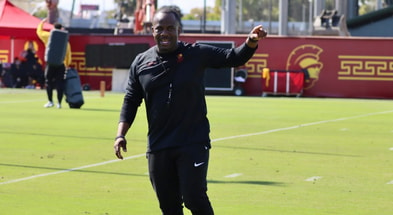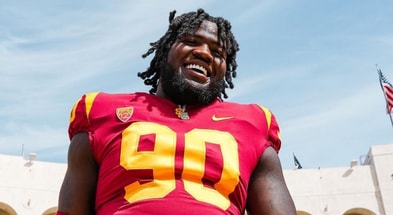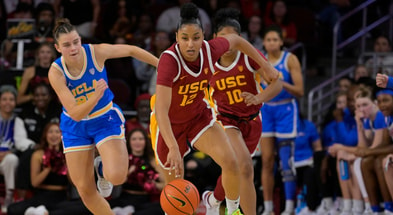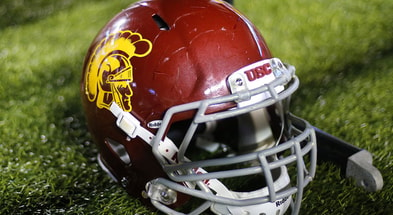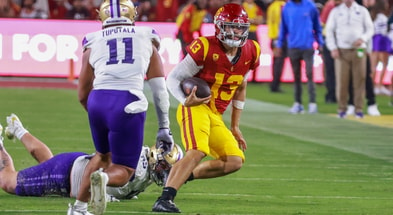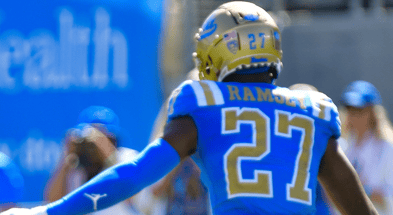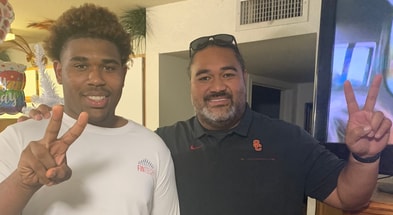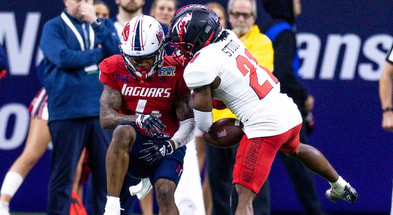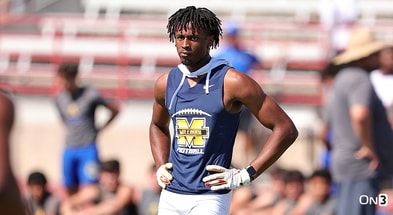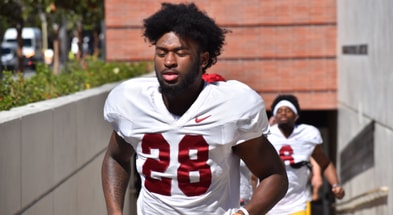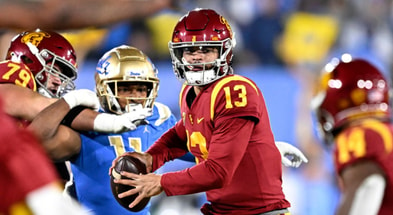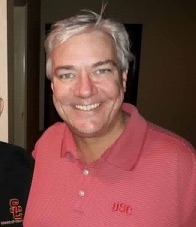Musings from Arledge: The Golden Years, Amateurism and Infinitesimally Small
I remember walking out of the Horseshoe with my dad in 2009. The Trojans were ranked number three – top rankings being a given in those days – and had just beaten a top-10 Ohio State squad on the road behind a freshman quarterback. I had been forced to listen to the most astoundingly obnoxious Ohio State fan all night. She yelled at me. She kept putting her OSU pennant in front of my face. She was just a bad person. As a rule I don’t believe in murder, but for most of the night she forced me to ponder whether my anti-murder position was more of a rule or a guideline, right up until Stafon Johnson’s touchdown run in the final minute shut her up for good.
It was a great night, the latest in a string of great nights. I knew it would end eventually. I didn’t know it would all come crashing down so soon, of course. But I knew runs like that can’t last forever. And having started by time as a USC football fanatic in 1984, I knew that things would take an ugly turn eventually. I’d seen plenty of ugly. I remember telling my dad that I didn’t know when the run would end, but that I was so thankful to have seen it. I have a similar feeling when it comes to college football.
For those of us who love college football, and you’re probably not reading this article if you don’t, we may have just lived through the golden years of the sport. College football has been splashed all over the television, with many dozens of televised games every week. Its popularity rivals that of any professional sport not named the NFL. Its heroes and villains – from Tim Tebow to Nick Saban, Urban Meyer to Reggie Bush – became household names. And the level of play has been extraordinary: great athletes playing a diverse and quickly evolving game, with even the NFL forced to turn on the tube on Saturdays to see what’s new with football.
I don’t know how long that run will last. I think it may be coming to an end. But I’m glad I saw it.
All sports eventually fade in popularity. Baseball was America’s pastime once. There are still plenty of baseball fans, but baseball doesn’t resonate the way it used to. Boxing used to be huge. Now it’s a highly lucrative but niche sport. College football will eventually fade as well.
We’ve talked before in Musings about some of the headwinds that college football faces. The more we know about CTE and long-term concussion damage, the more perilous football’s future. At some point, the damage may become too much, the mass of spectators may avert their eyes, or the talent pool may dry up as moms move their kids to other sports.
The unfairness in the economics may catch up to the game. The administrators from colleges, conferences, and the NCAA continue to talk about amateurism. They continue to craft rules designed to protect this alleged amateurism – rules that ignore the market reality of the situation and therefore create black markets, because there’s no such thing as “amateurism” in an industry that makes millions for coaches, hundreds of millions for universities, and billions for broadcasters. Who, exactly, is the amateur here? Dabo Swinney? Kirk Herbstreit? The president of ESPN? Larry Scott? Well, okay, maybe Larry Scott, but we can agree he’s a very highly paid amateur with a nice office.
College football isn’t amateur; it’s collusion, with the universities and media teaming up to control the type and amount of compensation paid to the labor so they can keep the bulk of the revenues for themselves. There are some valid reasons for the system we have, but that system is old, inconsistent with market realities, and is coming to an end,
and soon. We don’t know what will replace it.
And, of course, it becomes harder to square major-college football and basketball with the stated mission of the universities. Universities claim to be about education. The players are supposed to be student-athletes. But when schools routinely bring in students that are absurdly unprepared and unqualified compared to the rest of the student body, then demand that they spend the bulk of their time on a field or in a weight room, and shuttle them through fake classes and fake majors, we all know there is something inconsistent between the universities’ stated mission and the essentially pro sport they are running on the side.
Now maybe this probably doesn’t matter, being that most universities seem to have abandoned the free exchange of ideas and other parts of what we have traditionally regarded as education. University presidents may just be Roman emperors, spending vast sums covering up the underlying rot of their societies with fancy marble buildings. Why not run unprepared students through fake classes purely for monetary gain?
Now we have a season cancellation, or maybe a partial season cancellation as we wait to see what the other major conferences do. Do the fans come back next year? Some will, obviously. I will be watching USC football until I die, the world ends, or USC football shuts its doors, whichever comes first.
But for many schools, including both LA programs, it’s not easy to hold onto a fan base. Attendance at USC games has been spotty for some time now, as the glow and goodwill of Pete Carroll’s magical run has faded and given way to the more mundane reality of – hmm, let’s see, how shall I put this? – less-competent leaders? And once fans are forced to miss a football season, once they end traditions that in some cases have been around for more than a generation, it may be difficult to bring many of those people back.
In 1998, the Dodgers traded Mike Piazza. I was furious. A life-long Dodgers fan, those Dodgers teams weren’t great, but at least I could watch a future Hall of Famer. I decided to boycott the remainder of the season out of spite. I never went back. I haven’t seen aDodgers game live in 22 years, and I haven’t watched more than a handful. Once you leave, you don’t necessarily go back.
College football is still a great product. There is still a demand for it. And all these problems could be overcome with the right leadership.
Where can we expect to find that? From the corrupt band of fools (or “fair-minded folks,” depending on your perspective) at the NCAA office? Other than rubber stamping draconian sanctions against USC football and ignoring more serious wrongdoing by the rest of the college football world, is there anything that Mark Emmert actually does? He and his team have been embarrassingly behind the curve on this whole pandemic question. I think I’ve talked about it more than he has and, sadly, probably as effectually.
Can we expect the conference commissioners to salvage the situation? Maybe Larry Scott can ride to the rescue? He has, according to his own official bio, “led the transformation of the conference’s media posture by delivering much-needed revenue.”
That sounds impressive. Maybe he’s the guy to help work through these thorny problems. (Seriously, read the whole bio. It’s fantastic.)
Will the university presidents rise to the occasion? Universities are run by academics, and I don’t know if you’ve heard, but the culture of today’s academy is a world away from the culture that gave birth to and loves college football. And with colleges making so much money from other sources, even the big money of college football and basketball may not be enough to get the Carol Folts of the world to care about football.
Well, this got depressing. I shouldn’t write after a USC loss or a season cancellation.
So let’s end this section on a high note. I’m not sure where college football is headed. I’m not sure where USC football is headed, though my usual glass-half-empty perspective doesn’t see any national championships in our future unless somebody kidnaps Carol Folt and forces her to hire Urban Meyer.
But whatever happens, I’m sure glad I got to see what I’ve seen. Beating #1 Washington at the Coliseum in 1984. Beating Aikman and the Bruins in ’87 and ’88. 27-0. Bush Push. OU in the Orange Bowl. 1 st and goal from the 9 for Aaron Rodgers and Marshawn Lynch. Marcus Allen. Reggie and Matt. Mark Carrier. Keyshawn. OT against the Irish in ’96. Sammy Knight. Carson. And I’m sad that there’s no chance of adding to those memories this year.
Okay, let’s talk about it, hopefully for the last time.
As expected, the Pac 12 cancelled its football season. I could be glib – I’m not above it – and note that many of us questioned the Pac 12’s football commitment well before this COVID cancellation. But here that would be wrong. This was a serious decision made by serious people. (Serious people and Larry Scott. Sorry, Larry. I didn’t mean to leave you out.) I’m sure the people in charge did what they believe is right.
But I do wonder whether they answered the right question.
The final nail in the 2020 season’s coffin seems to be the danger of myocardial inflammation, or myocarditis. This is a real potential problem, even a deadly one sometimes, and doctors do not yet fully understand the connection between it and COVID.
According to David Chao, the former team doctor for the San Diego Chargers, everybody understands that COVID might cause myocarditis, and this may or may not be reason to cancel football. Dr. Chao articulates the terms of the debate here.
But there is something important missing from this debate. I don’t see it in Dr. Chao’s article. I don’t see it in any of the press releases or public statements from the Pac 12 or Big 10. And I asked for it specifically; I emailed multiple people from the Pac 12, one from the Big 10, and about half the doctors on the Pac 12’s COVID advisory committee.
And so far nobody has pointed me to the answer to my question.
Here’s the question: what is the increased likelihood that a player will contract COVID if we have a season compared to the likelihood that a player will contract COVID if we don’t?
Isn’t that the question we need to answer?
Look, we all know that some college football players will be exposed to COVID, some will catch the disease, and some will suffer adverse consequences, possibly even death.
But everybody runs that risk. All of us – by virtue of being alive in 2020 – risk exposure to COVID and its effects, including myocarditis. Millions have already been infected worldwide – none of them, as best I can tell, because they were playing college football.
Simply put, the season may be cancelled, but players in the Pac 12 and Big 10 still risk contracting COVID. The question is whether their risk of contracting COVID has decreased because we cancelled the season and, if so, by how much.
This is why what passes for analysis on this issue is so frustrating. We get stories about people who caught COVID and talk about how terrible it is. I don’t doubt that it’s terrible for many of its victims, but the awful experiences of these victims are not a rational argument that football is unsafe. We get analysis from faux experts about how some college football players might die of COVID.
But we don’t get an answer to the key question. The question is not whether COVID is dangerous for young, healthy athletes. (It is dangerous for some but probably not many of them.) The question is not whether myocarditis is dangerous. (It is, although doctors should be able to identify the symptoms and remove an athlete from competition if they develop myocarditis.) The question isn’t even whether it’s dangerous to play football during a pandemic. (It’s dangerous to play major-college football all the time. This is already a very risky activity.)
The question is whether having a football season will cause more players to get COVID than if we don’t have a season and, if so, how many more. That’s the question. Has anybody answered it? Nick Saban and others have argued that players are less at risk if football is played. This is a serious argument against cancelling the season. Because if Saban is right, then cancelling the football season will not make any player safer.
It’s easy to dismiss Saban’s statement as self-serving and ignorant. But not so fast: Dr. Cameron Wolfe, an infectious disease expert from Duke who is advising the ACC, apparently agrees with Saban: “We believe we can mitigate it down to a level that makes everyone safe. Can we safely have two teams meet on the field? I would say yes. Will it be tough? Yes. Will it be expensive and hard and lots of work? For sure. But I do believe you can sufficiently mitigate the risk of bringing COVID onto the football field or into the training room at a level that’s no different than living as a student on campus.”
If he is right, what have the Pac 12 and Big 10 done? If the SEC plays, and if SEC college football players end up having a rate of infection equal to the other students at those universities, then there is no reason to believe that playing football was an irresponsible choice. To the contrary, it was the right decision, because schools would have kept their promises to these students and will have avoided depriving them of an important life and, in some cases, career-building opportunity. Some SEC players may get sick – it’s even possible that one or more could die – and the SEC’s decision still could be reasonable. You can get sick outside of football. It is simply the case that in pandemics, people get sick and die, and it is very difficult to keep that from happening.
The issue is one of causation. Some number of redheads will die from COVID. This is not an argument in favor of dying your hair or shaving your head, for red hair does not cause infection. Unless playing football causes an increase in the rate of infection, cancelling football is irrational.
On the other hand, if football does cause more of a risk, then we need to understand how much more, and then we can discuss who should be allowed to decide whether playing is worth the risk.
Have the Pac 12 and Big 10 done this analysis? If so, can we see it?
I may be wrong about all of this. Maybe the Pac 12 and Big 10 concluded that players are far more likely to catch COVID if they play football than if they don’t. But because I haven’t seen that analysis or heard anybody talk about it, I think something different is going on, something a little less noble.
Indeed, Robert Robbins, President of the University of Arizona, concedes that the likelihood of a “major, adverse event” happening to a college football player is “infinitesimally small.”
The Pac 12 cancelled a season over a risk that is “infinitesimally small”? They denied some players the chance to live their dreams and build resumes for NFL scouts over a risk that is “infinitesimally small”?
Nobody wants COVID deaths. And every athletic department is addicted to the mountains of money that come with major-college football. The dispute, I believe, is not between those who care about athletes’ health and those who don’t. This is a dispute between those who are willing to risk receiving blame – fair or unfair – when a player inevitably gets sick, and those who are simply not willing to risk receiving blame. It’s a dispute between the risk-averse and the less risk-averse.
I think when the universities are making this decision, their focus is not on whether football brings an increased risk of catching COVID; I don’t think they know the answer to that question. I think their focus is can we tolerate the bad publicity and lawsuits if somebody gets sick and dies (knowing they will get blame even if that somebody would have gotten sick and died apart from football). The Pac 12 and Big 10 will forego the riches to avoid the potential blame. The SEC, Big 12, and ACC aren’t yet sure.
Or maybe the Pac 12 agrees with Duke’s Dr. Wolfe that you could do it, but it would “be expensive and hard and lots of work” – and they’re just not willing to commit to that.
